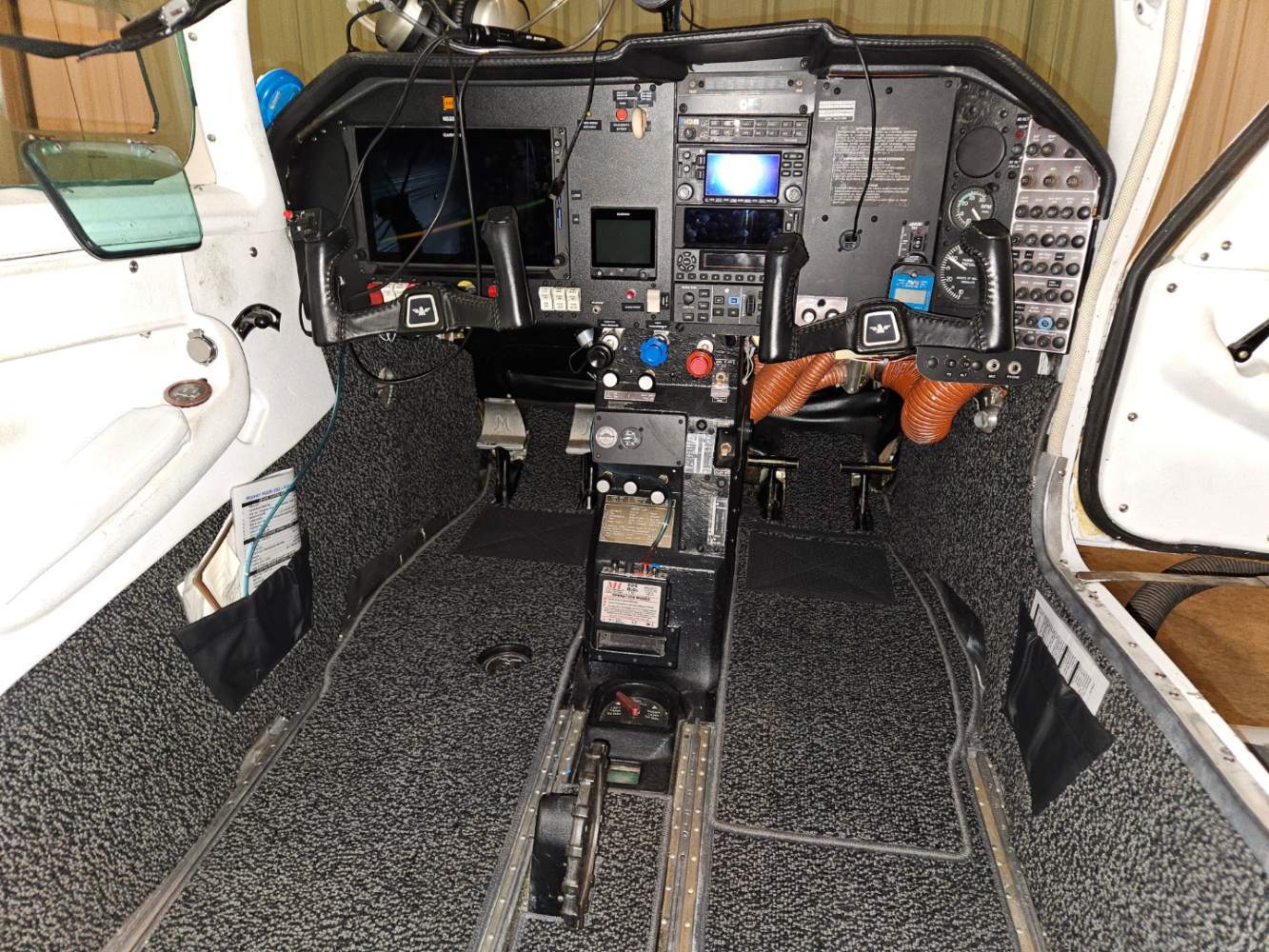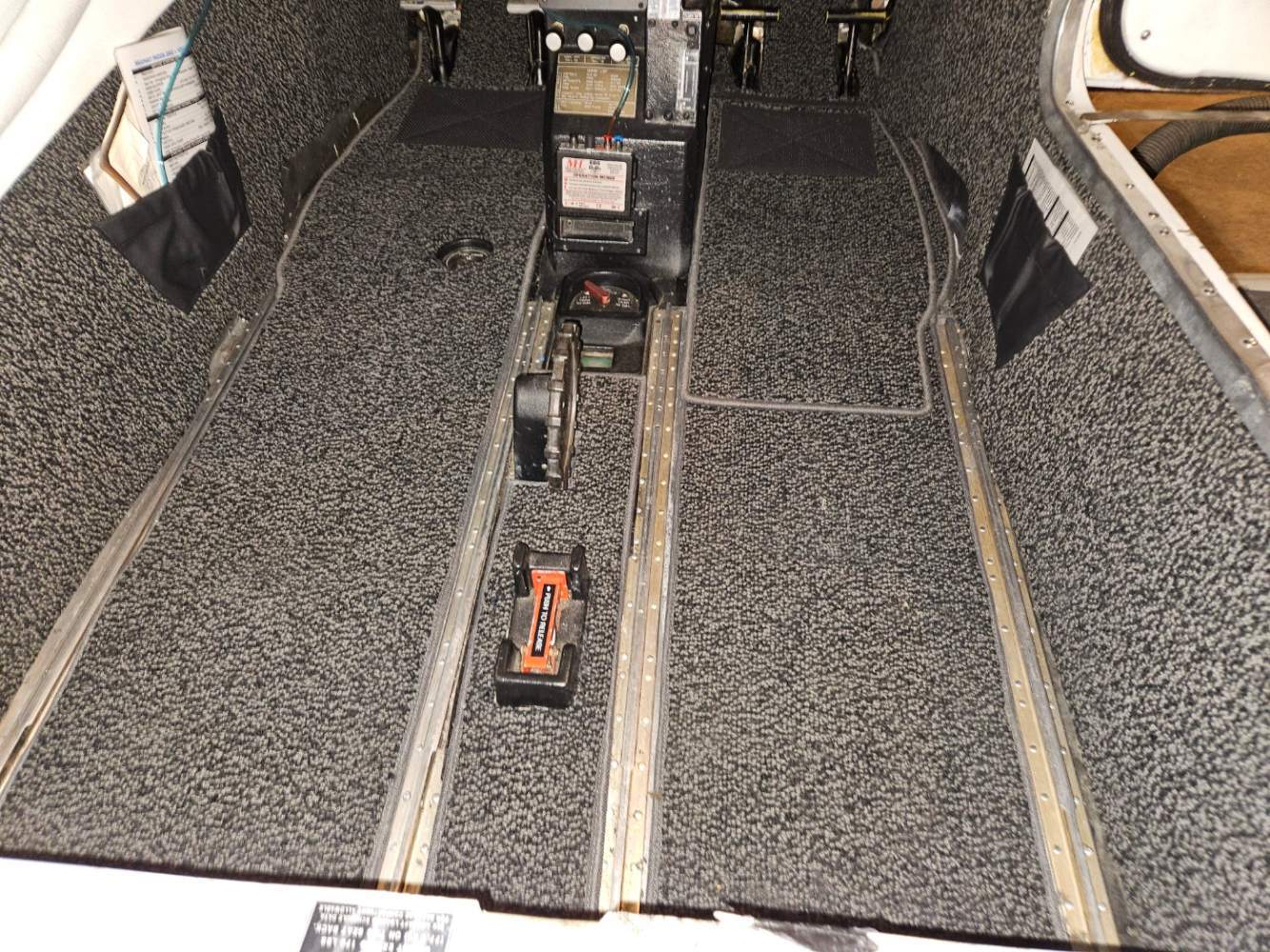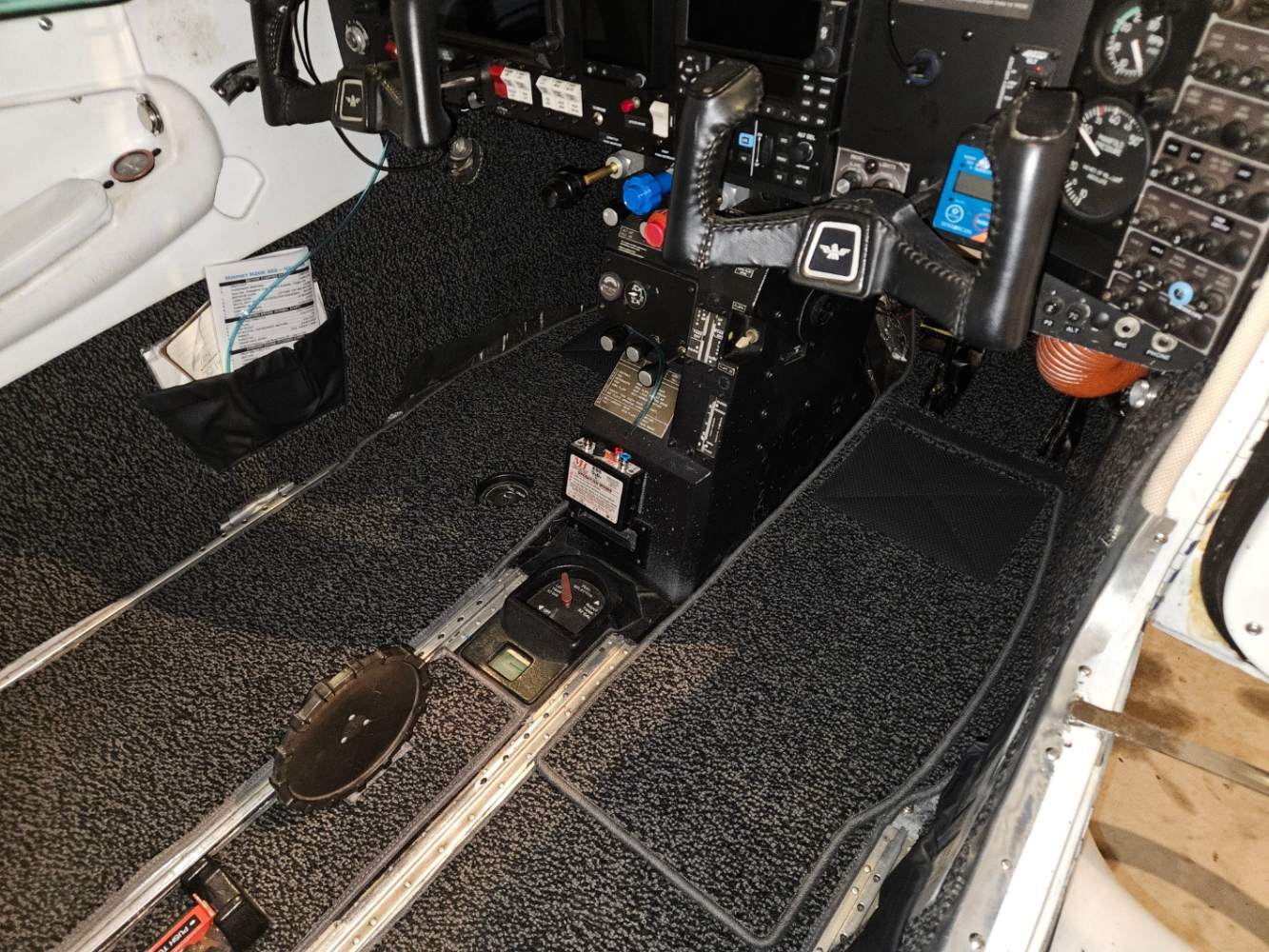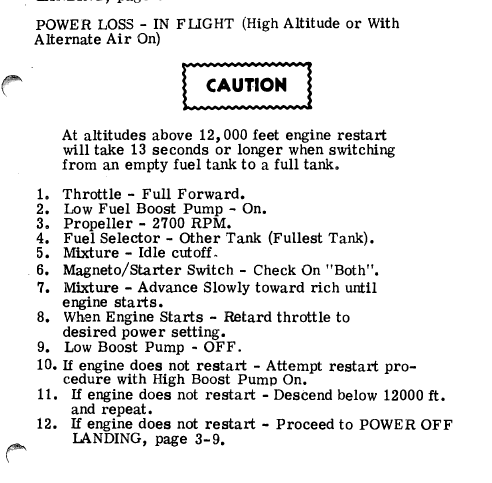-
Posts
660 -
Joined
-
Last visited
-
Days Won
3
Content Type
Profiles
Forums
Blogs
Gallery
Downloads
Media Demo
Events
Everything posted by Z W
-
It's a floormat that came with the carpet kit from SCS Interiors. Great kit. There's a matching one for the pilot's side, but it covers the fuel drain valve, so I opted not to install it out of fear that I'd forget to drain the fuel as part of the preflight. I have since removed the copilot's floormat also, because it looked lopsided with only one side installed. I considered trying to cut a hole in the pilot's floormat for the fuel drain valve. Still could, but I'm not sure it would look good.
-
Here are some I took after putting in new carpet. It's a 1982 model year 262 conversion but I believe the interior is all from a 252 model. Hope it helps.
-
Had a KAP-150 that started acting up. Chased problems with it for a couple of years. When they go bad, they can have some undesirable failure modes. The last time, about 50% of the time, when you engaged the AP, the right wing wanted to drop 30 degrees. Not pleasant in IMC or with passengers. It also would randomly just stop capturing the glideslope on approaches. Shops were confused. Some chance it was the old King HSI driving it that was failing. Not many people wanted to work on either the HSI or the KAP-150, or understood how it all worked, and this was in 2018-2019, I suspect it would be worse now. Never did figure that one out. We put in the GFC500. Huge difference in the way the plane feels to fly. Reliable. Easy to use. Intuitive. Safe. Would do it again, despite the cost.
-
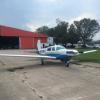
New engine will not start after already been started
Z W replied to Dick Denenny's topic in Vintage Mooneys (pre-J models)
The theory here is this: You had a perfectly running engine at shutdown. For shutdown, all you did is move the mixture to idle. There's still gas in the lines, primed and ready to enter the cylinders. The throttle is already cracked and set to idle speed. If you put the mixture back to full rich and crank, you're returning the engine just back to how it was a few moments before when it was running happily. It should re-start. This works only on short turns, such as refueling or loading or unloading passengers. If the plane sits for longer (30+ minutes) the fuel in the lines may vaporize from engine heat (vapor lock), drain back to the tank, or drain or evaporate out of the carb. Then you have to either re-prime, flush the lines with cool fuel from the tanks, or something else to return the cylinders to the proper fuel/air mixture to run. But after a quick turn, I will typically just crank first and see if it fires. If it doesn't, then you know it's safe to add more fuel without flooding the engine. -

New engine will not start after already been started
Z W replied to Dick Denenny's topic in Vintage Mooneys (pre-J models)
If the flooded start procedure is working (mixture full lean, throttle full forward), then I would suspect your engine is getting flooded somehow as you try to restart. In many engines, after a short shutdown, you can just put the mixture back in, turn the mags on, and crank to restart, and any boost pump or priming activity before that or along the way will flood the engine, requiring the use of the flooded start procedure. I'm not familiar enough with the E engine to recommend a hot start procedure for it, but I bet if you post here what you're trying to do that isn't working, you'll get some suggestions. -
When I tackled this job, I drained the old fluid out through the calipers while keeping the reservoir in the tail full. Got a fair amount of chunky brown fluid out of the calipers when I opened the bleeders. Kept going until fresh red 5606 came out. Still ended up with some air in the system due to changing the old stiff brake lines at the same time. Refilled from the bottom up using a pressure pot. Went OK, but the cheap Amazon pressure pot wasn't really up to the task. Next time I would buy a better one or try the oil can linked here. And the 5606 has eaten up that plastic pressure pot. I would use the synthetic fluid if doing it again, and also order the AN fitting to seal up the reservoir in the tail, which I did not have. Brakes worked afterwards but weren't even, had some softness in the right one until the second pump. Flying, changing attitudes, and pumping the brakes got it to better, but not perfect. Don Maxwell's shop fixed it all up at the next annual. Don't know what they did, but they were better at it than me. It seems to be a job best done by someone with the proper equipment and fittings, and maybe some experience, if that's an option.
-
I have a G500TXi. The chart overlay feature shown works OK, but is a little clunky. Like Don said, it's always track up, or at least it stays track up since that's what I have the MFD map set to. So you may be reading the numbers on the chart sideways or upside down. It also zooms in too much, automatically, and repeatedly. Like, so far in you can only read the step-down altitude of the leg you're on, and you have to keep zooming out to see the next leg, or how far you are from the airport. Zooming out is easy, but you have to do it so often it's annoying, as it zooms in again at each fix. If they fixed the auto-zoom feature it would be a lot more useful. Come to think of it, I should check and see if that's an adjustable setting, which I've never done. The chart overlay makes it pretty much impossible to get confused as to what part of the approach you're on, so that part is good, but I always have the chart open on my phone so I can read all of the data and information easily. Or, once I'm established on the approach plate, I'll just switch the G500TXi's MFD off the map to show the approach plate itself instead, which is then the proper orientation and still shows the geo-referenced blue airplane dot on it. Once on approach, the map overlay feature seems to me to be of little use. It's more helpful while you're 50 miles out and wanting to get oriented about where the approach and potential missed is going to take you in relation to the rest of the world. I always thought that was its intended use, and not trying to fly the approach itself on the map page. But you can certainly fly an approach with it. Never knew the G3X didn't have that feature. But I wouldn't miss it too much if I were choosing between the two today.
-
Whenever you have it ready, let me know pricing and how to order. Thanks @Gee Bee Aeroproducts
-
Not sure about the replacement or adhesive, but Peerco 321 Adhesive Remover did a great job removing the old glue from my door where the seal used to be without stripping any paint. https://www.aircraftspruce.com/catalog/cspages/peerco02-00234.php My research showed off-the-shelf factory-style replacements weren't easily available. But I did stop short of calling the factory. Hope you find one.
-

How to remove the front pilot seats?
Z W replied to Modify201's topic in Vintage Mooneys (pre-J models)
Also, if you buckle the seatbelts and tighten them up all the way, they make a nice handle for lifting the seats in and out of the plane. And it keeps them from flopping around and banging on the wing as you carry the seats in and out. -
That's a nice looking F model at a good price. I think those late-model F's are a great value in the market. Having it looked at by a good mechanic is recommended. Have them look for corrosion. Most everything else can be fixed reasonably. If I were buying, I would open up all the inspection panels myself and spend a lot of time looking around the inside with a mirror, flashlight, and borescope camera. Make sure it has complete logs before you invest much time or money. Most lenders will not finance a plane with any of them missing. Be ready for the first year or two to spend a bit on catch-up maintenance. There is usually some that gets deferred after the owner decides to sell. Or it has been sitting, and things will break as you start spinning them back up. I would budget at least $10k per year for those years for maintenance, and hope it was less. Not trying to scare you off, just something I think all new aircraft owners should know, so you don't have a bad experience. Good luck!
-
Had never heard of these, but just ordered some. Looks like Simple Green makes something similar too. Going to try those also.
-
I've had problems with most of the system, but not the regulator. It's a pretty simple system actually, just lots of places leaks can develop. Currently have all the leaks fixed. What's the problem with yours?
-
Congrats on persevering through what I'm sure was a frustrating struggle. And now you know your plane that much better. These birds are all unique creations at this point after years of modifications and improvements with unique installations. Probably why it costs so much to get them worked on...
-
-

Intermittent Rough Engine / High EGT need help diagnosing
Z W replied to 33UM20C's topic in Engine Monitor Discussion
The plug fouling could have been related to that particular plane's setup, I don't know. I was told it was because the carb was set for sea level ops, and my home base was at an elevation of 1,000 feet. But it would foul quickly during taxi at full rich mixture. -

Let the games begin - MAJOR Avionics Upgrade.
Z W replied to Pinecone's topic in Avionics/Panel Discussion
Just one data point, but the START POWER ON annunciator came out of our panel redo inop, along with most of the other warning lights in the annunciator strip. I believe the only ones that still light up on test are the GEAR DOWN, GEAR UNSAFE, and ALT AIR. -
I've landed a couple of times with a low fuel light on one side, and the other tank reading between 5-10 gallons. Once on purpose which convinced me not to do that again. The second time, more recently, after getting shorted on a fuel order and then hitting greater than forecast headwinds. Both times made me extremely uncomfortable. I greatly prefer to get extra fuel, or stop for more. The M20K doesn't take much fuel to get there - 12 more gallons gives you an hour of time and 160+ miles of range. The stock 75 gallon tanks give you 6.25 hours of flight and 1,000 miles of range, and unless you're hauling 4 adult males, the plane can usually be flown easily within W&B with 75 gallons on board. It's the most efficient model in the fleet for this. I don't see a lot of reason to be landing, taking off, or going around with less than 12 gallons in both tanks, so I don't do it. My thoughts only. Your experience may vary.
-

Intermittent Rough Engine / High EGT need help diagnosing
Z W replied to 33UM20C's topic in Engine Monitor Discussion
Another thought - You could do the ground run and data download prior to departure without a CFI, I would think, at minimal risk to the plane and your insurance policy. I think I would do that before scheduling the flight with a CFI and feeling the pressure to fly. I will never takeoff in a plane that doesn't show everything normal at run-up on the ground, and I've been pressured by various mechanics and other pilots to do so several times. In your situation I would even do some extended full-power ground run-ups and hold the engine there for a minute or two to watch the EGTs and CHTs. Then download the data and share it here. Once you're confident everything is sorted out on the ground and good to go, you could schedule the CFI with more confidence. -

Intermittent Rough Engine / High EGT need help diagnosing
Z W replied to 33UM20C's topic in Engine Monitor Discussion
I had a M20C with that engine for several years. It would very quickly foul a plug during taxi if you did not lean it aggressively. If you forgot to lean, it would remind you at the mag check during run up, where the engine would immediately run very rough and cough and shake. You could cure it by burning the plug clean. The procedure was to lean aggressively, set mags to both, set the throttle to 2,000 RPM, lean some more until you saw the RPM drop slightly, and hold it there for 30 seconds to 1 minute. Then repeat your mag check. Every time, this would result in a clean plug and a plane ready for takeoff. I would then smack the back of my head for forgetting to lean, and leave it leaned out until departure. I assume you did a proper run up and mag check prior to this flight, and did not see the above behavior? I never took off with a fouled plug and don't know if it would cause what you're seeing, but since this plane is new to you, I thought I'd suggest starting at step one. If you're able, next time, do a full extended run-up, maybe another test flight if all is good, then download the engine logs from your JPI, and post the links here. I've done that before and this community is amazing with their ability to look through logs and help you diagnose. -
When we redid the carpet we took the time to tape up all the seams and holes around the cabin with some high-quality duct tape, after reading that helps prevent CO intrusion as well as cabin drafts. There are quite a few seams, gaps, and open holes in the floor. Our exhaust dumps right under the right hand side of the engine. Got one of the sensitive CO monitors a couple years ago. It shows up to 5 PPM on the ground with the door and window closed. Sometimes up to 12 PPM on the ground with the door/window open in the summer. Have never seen higher than that on it.
-
I use a Switcheon also. Works great. One plug operates the battery charger, the other the Tanis engine heater. I keep a set of cowl plugs in it, but no blanket. If I expect to be flying, I'll turn them on the night before. If I wake up and decide to go flying, I'll kick them on, and even after just an hour or two, the engine gets warm enough to start easily. Maybe not ideal but better than nothing. This is relatively mild Midwest weather. If it's subzero I usually am not flying, but if I were, I'd turn it on at least 12 hours before. Plane is in an unheated and uninsulated T-hangar. Engine heater stays plugged in (but turned off) during the colder months. The Switcheon also has a built-in thermometer that tells you the air temp in the hangar. It's always already about 20 dF warmer than outside, which surprised me. I did have to relocate the Switcheon over by the hangar door with some extension cords to improve reception. Had a few times where it lost signal and you couldn't turn it on. Moving it seems to have fixed that problem.
-
When you need the turbo and O2 to clear a mountain pass in a downdraft, climb through or above clouds in the freeze levels, takeoff at max gross from a high and hot runway, or climb above a layer of popcorn clouds and turbulence into smooth clear air, I doubt you'll be crunching the numbers on how much it cost you that year. When you climb up high in the teens to catch a 50+ knot tailwind headed east or south, you'll probably just be smiling. Somehow I usually have headwinds both ways, but sometimes it does work out. I'd say most years it requires no extra maintenance cost. Some years, a couple thousand dollars. When the turbo itself needs overhauled, it'll be more maybe. I did have to buy a new oxygen bottle last year, because the old one was timed out, for around $4,000.00. But the new one is good for another 12 years I believe.
- 35 replies
-
I bought one straight from Redline last year. Works great and no worry of scammers. I assume you know that's an option and are just trying to save a little money? Not that there's anything wrong with that. They seem to sell really fast when posted here and on other aviation websites. You could keep an eye out over at Beechtalk.com as well. Good luck.
-
Love the turbo. Would not want to switch to a plane without one at this point.
- 35 replies


